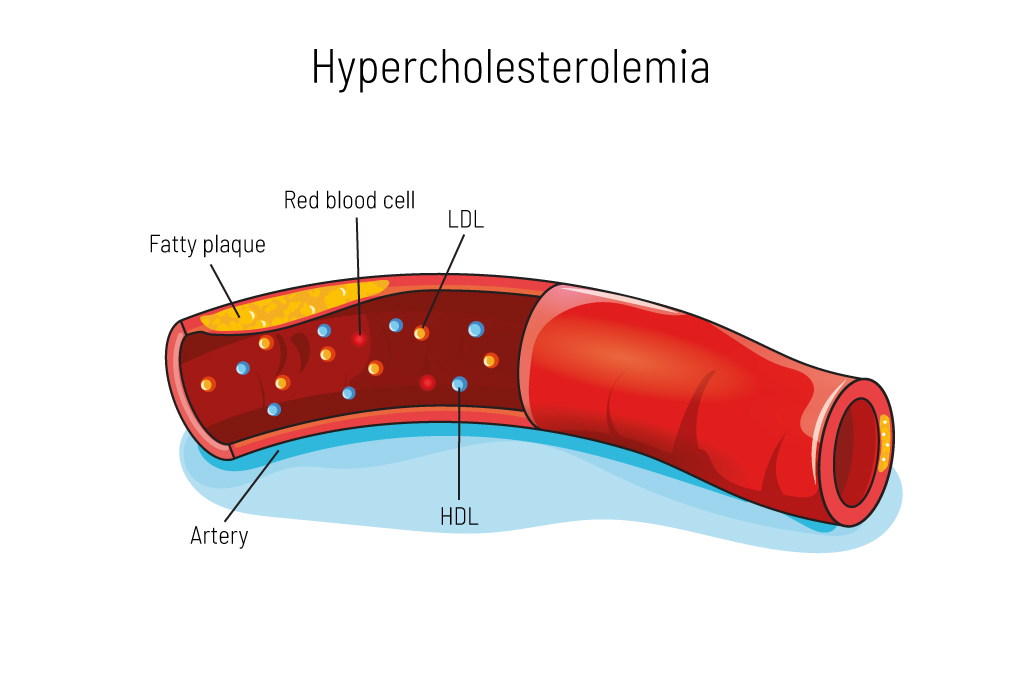In hypercholesterolemia, the fat metabolism is disturbed, leading to higher blood lipid levels (e.g. Low-Density-Lipoprotein-Cholesterol, short LDL cholesterol), that can, for example, increase the risk of heart attacks. If a predisposition for hypercholesterolemia is known and LDL cholesterol levels are elevated, preventative measures can be taken to reduce the level of cholesterol and thereby lower the risk for a heart attack.
Are you insured in Germany? Our colleagues at the Zentrum für Humangenetik Tübingen will gladly support you!
What Is Hypercholesterolemia?
Cholesterol is an essential part of our body and is needed e.g., to build hormones or for the structure of the cell membrane. Cholesterol, like fats, does not dissolve in blood. Therefore, a transportation system is needed to spread cholesterol in the body. For this, HDL (high density lipoprotein) and LDL (low density lipoprotein) complexes are used.
Figure 1: Hypercholesterolemia is a lipid metabolism disorder in which, e.g., LDL cholesterol, also called the “bad” cholesterol, is present in the blood at elevated levels. If too much of it is present in the blood, it accumulates in the arteries and can lead to the formation of fatty plaques. This increases the risk for heart attacks and strokes.
HDL transports excess cholesterol in the body to the liver, where it can be degraded. In general, it is called “good” cholesterol. LDL transports cholesterol from the liver to other body cells. These cells can take up the LDL with the bound cholesterol via a specific receptor, the LDL receptor. An increased level of LDL is associated with an increased risk of cardiovascular diseases. Therefore, LDL is commonly known as the “bad” cholesterol.
With familial hypercholesterolemia (FH), in 85% to 90% of the cases, there is a variant (change) in the gene for this LDL receptor. This can lead to an impaired uptake of LDL cholesterol into the cell. Therefore, it concerns a hereditary disorder of the fat metabolism. In familial hypercholesterolemia, LDL cholesterol can rise to two to ten times the normal value. The elevated LDL cholesterol level in the blood increases the risk of deposits in blood vessels in the form of fatty plaques and therefore also the risk of e.g., heart attacks
(figure 1).
It is assumed that this disorder occurs with a frequency of 1:500 but is only diagnosed in 15% of cases. In young people, a lipid metabolism disorder is usually only diagnosed after a heart attack. Other diagnostic factors are:
- an accumulation of heart attacks in the family,
- Xanthomas (nodular fat deposits in the skin), or
- a vastly increased LDL-cholesterol level in the blood.
Through early diagnosis, the risk for vascular deposits and heart attacks is clearly decreased.
A form of therapy to reduce the blood glucose levels is the administration of lipid-lowering drugs (e.g. statins). In the context of the module Drug Metabolization (Pharmacogenetics), CeGaT investigates the genetic profile, that affects the metabolization of fat-lowering drugs (statins) in the body. With this knowledge, the treating physician can adapt the dose individually, according to the genetic profile. Also, other medications are included in this analysis. You can find more information on this here.
Field Report
Patrick R., 30 years old
Lifestyle: normal diet, not a lot of exercise
Result: By sequencing Patrick R.’s genetic information, an increased risk for elevated cholesterol levels through a variant in the gene LDLR was found.
Consequence: Patrick R. now has his blood fat values checked regularly. He pays attention to his diet and exercises regularly.
“I have experienced several heart attacks in my social environment, so I had my genes tested. The analysis showed that I have a change in the LDLR gene. Now I know what I need to do to prevent secondary diseases.”
How Does Genetic Risk Assessment Work?
With the Prevention Panel in the Module Hypercholesterolemia, four relevant genes are tested, including the gene for the LDL receptor and for proteins that influence the function of the receptor. An early diagnosis of the disease helps to timely treat it by reducing the LDL cholesterol levels and adapting the lifestyle, to prevent secondary diseases.
You Are also Welcome to Take a Look at the Following Areas
Contact Us
Do you have a question, or are you interested in our service?
Diagnostic Support
We will assist you in selecting the diagnostic strategy – whether as a person seeking advice or as a physician.





